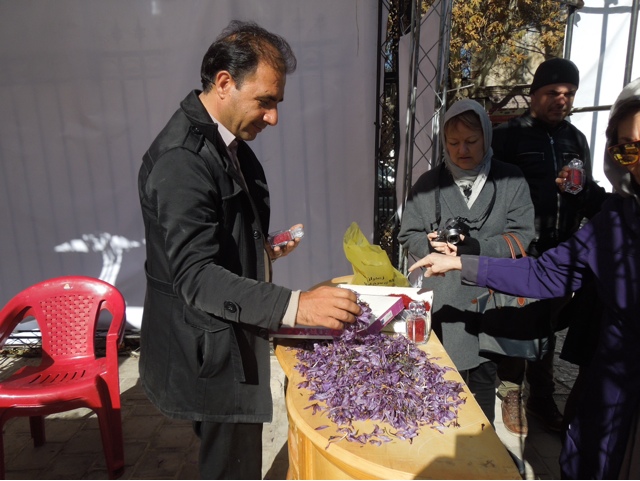I flew from DFW to Doha on Qatar - 14 1/2 hours; a two hour layover in Doha; and then a 90 minute flight to Tehran. I was greeted at 11:30 PM by a friendly driver who escorted me to my hotel in Tehran.
Tehran is considered to have one of the worst traffic problems in the world. I believe that the parking lot that was the network of roads surrounding the city, was proof that this was accurate. The city itself is a fascinating landscape of the old and the new. The elders uphold the past traditions in their dress and manner. The younger generation have developed their own fashion statements while observing the customs of the country. They are very friendly, are happy that you are visiting their country, and eagerly ask to be photographed with American visitors.
In a country that bans alcohol, and tobacco products, I chose fresh squeezed pomegranite juice as my beverage. I enjoyed staying in the old hotel rooms that were not filled with stale tobacco smells.
About 100 carpets and rugs are usually on show in this museum, opened in 1977. There is a replica of the Pazyryk rug (5thc BCE, the oldest known knotted carpet found in Siberia in the 1940's. There are examples of 16th-17th centuy Safavid rugs, including the so-called Polonaises, which caused a sensation at the 1867 Paris Universal Exposition.
All traces of the mid 18th century construction by the Zand regime were almost totally oblitered by the early Qajar shahs; Agha Mohammed ordered the bones of Karim Khan Zand to be exhumed from his Shiraz grave and placed under the main threshold to be trodden on by all.
The Marble Thone veranda is decorated with mirrors and other goodies seized by Agha Mohammed from the Zand palace. The throne-couch itself, was carved by Esfahani craftsmen in 1807, and was where the shah sat during public audiences.
The White Palace, there is a pair of bronze boots - all that remains of a huge statue of Reza Shah - standing by the steps. It was said that the army life so conditioned Reza Shah that he preferred sleeping on the floor than in a bed. The house does not feel lived in.
The Green Palace , is so called because of its faced with a distinctive special greenish-yellow marble. Reza Shah ordered this construction in 1925 and his small office is located in this building. Elsewhere the excess of mirror-work, blue brocade silk curtains with silver metal thread fringes, tasssels in the bedrooms and the crimson sild dining room speak more of the excesses of his son, Mohammed Reza.
Our first interesting bazzaar. Takiyeh of Muavin al-Molk with interesting tiled panels in the three performance areas. Those in the first courtyard reveal the function of the small complex with a large panel depicting a preacher reciting one of the Ashur eulogies about Hossin.
 Here's our "motley" ....don't we look like locals?
Here's our "motley" ....don't we look like locals?

 Here's our "motley" ....don't we look like locals?
Here's our "motley" ....don't we look like locals?BISOTUN (UNESCO World Heritage List) the immense rock face recording the vistories of Darius the Great dominates the skyline. It actually depicts the Achaemenid emperor Darius the Great with his generals behind him, standing vistorious on the rebel Gaumata who refused to accept the succession of Darius. Above a winged figure, generally identified as Ahura Mazda of Zoroastrian belief.
Anahita Temple remains from the Parthian period (247 B.C.-224 A.D.). Some believe the Assyrians first occupied this city in 1100 B.C., but Herodotus says it was the capital of Medes, an early Iranian people, around 700B.C.
The first grotto shows Sassanid shah holding the diadem or Ring of Authority, brought here from the Bisotun locale. The exact function of these two man made caves is unclear, but hunting themes dominate. A stylised "Tree of Life, from which alll known plants generate. In Zoroastrian belief this manifestation of Ahura Mazda crosssed the heavens daily in his sun chariot - thus, his halo of sunrays to check that all were keeping their word, but when he was adopted as a deity in his own that all were keeping their work, but when he was adopted as a deity in his own right by Roman soldiers , his rituals were followed in secrecy in underground temples.
This is considerd the most imortant pilgrimage site for Iranian Jews. The crypt, contains Hebrew inscriptions and a copy of the Ten Commandments.
A castle dating 1,800 years to the Sassanid era, the last Iranian empire before the rise of Islam.
The family residence of the Ayatollah Ruhollah Khomeini, the cleric who returned from exile and engineered the fall of the Shah of Iran.
"Argo" is a 2012 American historical drama film directed by Ben Affleck. The Canadian embassy sheltered the Americans in 1979 when Iranian activists storm the US embassy in retaliation for Pres. Jimmy Carter giving the Shah asylum in the U.S. durng the Iranian Revolution.
Built in 1971 as part of the Shah's 2,500th extravaganza. "Freedom Monument".










































































No comments:
Post a Comment